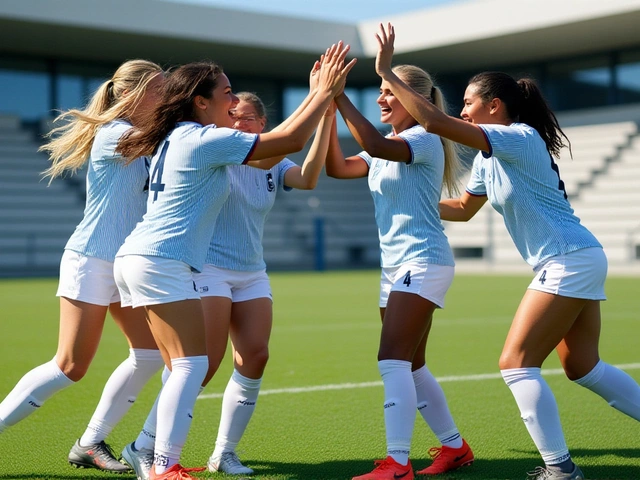When Mayagüez hosted the opening matches at Estadio Centroamericano, Puerto Rico, Honduras, Panama and El Salvador clinched the four spots that send them to the Final Round of the 2025 CONCACAF Women's U‑17 Qualifiers. The drama peaked on Jan 31, 2025 when Gabriella Garnett struck in the 33rd minute, only for Evans Welch to level for Bermuda. Then, in the 90+5 minute, Mía Colon shoved a loose ball home, sealing Puerto Rico’s 2‑1 win and confirming the quartet’s advance.
Round One: How the Four Winners Emerged
Round One unfolded over a week, from Jan 27 to Feb 1, 2025, across three groups. CONCACAF had arranged the fixtures to give each nation a chance to prove itself before the final showdown. Group A saw the host Puerto Rico juggle a tight schedule, ultimately topping the group on goal difference. Meanwhile, Panama hammered the Cayman Islands 4‑0, and Honduras scraped past their rivals with a narrow 1‑0 win, all under the watchful eyes of local fans.
El Salvador’s route was less flashy but no less effective. A disciplined 2‑0 victory over Saint Vincent and the Grenadines gave them three points, enough to edge out the competition. By the time the final whistle blew on Feb 1, the standings were clear: Puerto Rico, Honduras, Panama and El Salvador were the group winners heading to the Final Round.
Final Round Setup and Key Fixtures
The Final Round kicked off on March 31, 2025, at the Ato Boldon Stadium in Couva, Trinidad and Tobago. Twelve teams took part: four power‑houses (the United States, Mexico, Canada and Haiti) that earned byes, plus the six Round‑One winners and two best‑second‑place finishers (Bermuda and Trinidad & Tobago). The groups were seeded as follows:
- Group A (hosted by Mexico): Mexico, Haiti, Costa Rica, Bermuda
- Group B (hosted by Panama): Canada, Puerto Rico, Panama, Nicaragua
- Group C (hosted by Trinidad & Tobago): United States, El Salvador, Honduras, Trinidad & Tobago
Group C produced the headline‑grabbing moments. On March 31, Maya Buerger gave El Salvador the early lead, only for Jazlyn Sanchez to wrench a 1‑1 draw for Honduras. The United States thundered through their opening match, beating Trinidad & Tobago 3‑0 with goals from Ashlyn Anderson, Micayla Johnson and Chloe Sadler.
April 2 was a nightmare for Honduras as they fell 0‑7 to the United States, while El Salvador ripped apart Trinidad & Tobago 4‑0. The United States capped the group with a 7‑0 demolition of El Salvador on April 4, cementing a perfect 3‑0 record, 17 goals scored and none conceded – a goal‑difference that will be hard to beat.

Why the New Four‑Berth Slot Matters
The 2025 cycle is the first time the CONCACAF region enjoys an extra berth at the U‑17 Women's World Cup. FIFA’s decision to award four slots (instead of three) for the tournament in Morocco reflects the growing depth of women's football across North America, Central America and the Caribbean. The flip side? The United States, a six‑time CONCACAF champion, can no longer guarantee a championship title simply by virtue of a bye; they must now earn qualification through the same group stage as everyone else.
This change also opens a realistic path for smaller nations. El Salvador’s second‑place finish keeps them alive for a potential inter‑continental playoff, while Honduras, despite a heavy loss, still holds a glimmer of hope thanks to the expanded slots.
Voices from the Field
“It’s a huge step for the region,” said Latoya Dusta, head of Women’s Competitions at CONCACAF, during the draw ceremony in Miami. “The extra berth means a better chance for emerging programs to experience the World Cup stage.”
Players echoed that sentiment. After the United States’ 7‑0 win, forward Ashlyn Anderson remarked, “We know the competition is getting tougher. Winning this way shows we’re ready for the next level.”
In contrast, Honduras’ captain Jazlyn Sanchez admitted, “The loss was painful, but the experience will help us grow. The four‑berth format gives us hope we could be there in Morocco.”

Looking Ahead: What Comes Next?
With the Final Round concluded, the four CONCACAF representatives—United States, Mexico, Canada and the nation that clinches the last slot (likely El Salvador or Honduras)—will head to Morocco for the 2025 FIFA U‑17 Women’s World Cup in July. The tournament will be the first of five consecutive editions staged in the North African kingdom, offering a unique cultural backdrop for the young athletes.
For the qualifying nations, the real work begins now: scouting, training camps, and friendly matches to fine‑tune squads. The expanded berth also means national federations across the region will receive more funding from FIFA, potentially accelerating grassroots development.
In short, the 2025 CONCACAF Women's U‑17 Qualifiers have reshaped the competitive map and set the stage for a new era of opportunity.
Frequently Asked Questions
How does the new four‑berth allocation affect smaller CONCACAF nations?
The extra slot increases the odds that nations like El Salvador or Honduras can reach the FIFA U‑17 Women’s World Cup. It also means more funding and exposure for their youth programs, which could boost long‑term development.
Who were the standout players in the Final Round?
Besides the United States’ prolific scorers—Anderson, Johnson and Sadler—players like Mía Colon (Puerto Rico) and Gabriella Garnett made crucial contributions during Round One, while Maya Buerger sparked El Salvador’s offense.
What were the key dates of the qualification process?
Round One matches ran Jan 27–Feb 1, 2025. The Final Round took place March 31–April 6, 2025 at Ato Boldon Stadium. The FIFA U‑17 Women’s World Cup is scheduled for July 2025 in Morocco.
Which officials oversaw the decisive games?
Refereeing duties were shared among Marjorie Ponce (Nicaragua), Neressa Goldson (Jamaica), Dilia Bradley (Guatemala) and Suleimy Linares (Cuba), each appointed by CONCACAF to ensure fair play.
What does this qualification mean for the United States?
The United States secured the top CONCACAF spot with a flawless 3‑0 record and a +17 goal difference, guaranteeing their place in Morocco. However, the new format means they can no longer rely on a guaranteed title; they must defend their dominance on the field.

